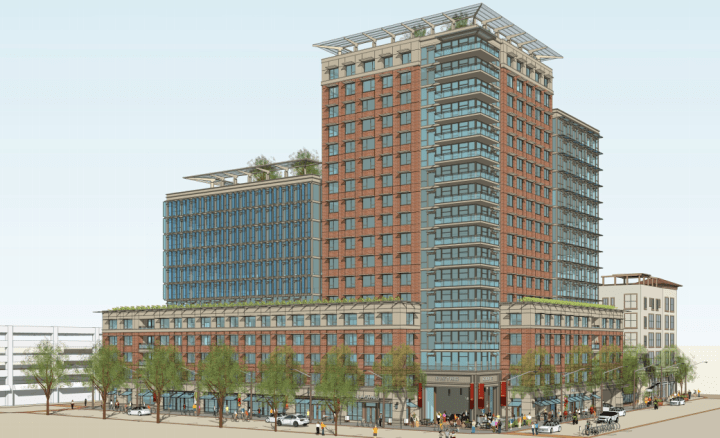
Update: This story was updated Jan. 15 to add another lawsuit. Scroll to the bottom of the story for details.
Kelly Hammargren, one of the most active opponents of the planned 18-story high-rise at 2211 Harold Way in downtown Berkeley, filed a lawsuit Wednesday charging that the city of Berkeley did not do an adequate environmental review of the 302-unit complex.
Hammargren filed her lawsuit on the last day permitted to file a legal challenge, which was 30 days after the Berkeley City Council’s Dec. 8 vote approving the project was certified. None of the other residents who opposed the 2211 Harold Way project joined Hammargren in the lawsuit, nor is there a law firm representing her interests. Hammargren intends to represent herself, at least for now.
Read complete coverage of 2211 Harold Way on Berkeleyside.
In 2012, when the then recently passed Downtown Area Plan was adopted, three neighborhood preservation groups joined together to file a suit against the city.
Even though Hammargren appears to be operating on her own, Becky O’Malley, who was a strong opponent of the Harold Way project, wrote in the Daily Planet that “a new citizens’ group has been formed to support the appeal with volunteer work and fundraising for legal expenses.”
The lawsuit means that construction on 2211 Harold Way will probably be delayed until the legal challenge is resolved.
Mark Rhoades, whose Rhoades Planning Group has been shepherding the project through the design approval process, had tried to stave off a lawsuit by announcing the developer of Harold Way would immediately give $250,000 to Habitot Children’s Museum if no lawsuit was filed. As it currently stands, Habitot would not get that $250,000 — part of the community benefits package the developer must pay — until the project is awarded a building permit which, without a lawsuit, would take at least a year. Habitot has to vacate its current space in the basement of the old Hinks Building on Shattuck Avenue to make way for the apartment complex, and needs the money to move.
The lawsuit essentially reiterates all the concerns Hammargren and other residents had about the 2211 Harold Way project. It alleges that Berkeley and others violated CEQA by not properly taking into account the project’s “significant impacts on water, sewage, seismic safety, shadows, wind velocity, transportation, traffic, air quality and noise, affordable housing on all income levels, nearby elementary and high school students and diversity.” The complaint also says the approval of the project “constitutes an abuse of discretion because the city relied on speculative assessments rather than required studies,” and was based on incomplete and misleading information, among other charges.
Hammargren’s complaint also said the project will further segregate housing in downtown Berkeley, which is a violation of the 1968 Fair Housing Act. There will not be any affordable housing units in the complex, she noted. Instead, the developer HSR Berkeley, created by Joseph Penner, is paying $6 million in in-lieu fees plus an extra $4.5 million in community benefits into a housing fund.
Hammargren could not talk to Berkeleyside, as she had a series of appointments on Thursday, but said she will respond to questions soon.
Update: Another Berkeley resident filed a lawsuit against the city of Berkeley, Joseph Penner, HSR Berkeley Investments, and Hill Street to block the 2211 Harold Way project. But the case was filed on Jan. 14, which is outside the 30-day limit allowed by law.
James E. Hendry argues that Berkeley’s EIR is inadequate because it is based on outdated information. In looking at transit usage figures, the EIR uses census date from 2000, making it 15 years old, said Hendry. In addition, the EIR does not look at the impact of the project on the already overcrowded BART system, he said in a court filing.
Related:
Berkeley approves construction of Harold Way highrise (12.09.15)
Berkeley city council to consider Harold Way appeals (12.08.15)
Numerous appeals filed for Berkeley’s Harold Way project (11.03.15)
ZAB approves Harold Way permit with increased affordable housing provision (10.01.15)
Harold Way project gets Landmarks Commission approval (08.14.15)
Op-ed: The Harold Way Project, as presented, will sacrifice Berkeley’s unique character (08.05.15)
New plan calls for 10 theaters at 2211 Harold Way (07.30.15)
Berkeley council adopts community benefits package (07.16.15)
Op-ed: Let’s say ‘yes’ to a vibrant downtown Berkeley (07.10.15)
Council declines to overturn LPC vote on Campanile Way (07.01.15)
Berkeley council to hear Campanile Way landmark appeal (06.30.15)
Council approves community benefits package; ZAB votes to certify Harold Way EIR (06.29.15)
Do you rely on Berkeleyside for local news? Support independent journalism by becoming a Berkeleyside member for $10 a month or even less, or by making a one-time contribution.
[Correction: Kelly Hammargren’s name initially was misspelled in this article.]
